Vending Machine Costs: New vs. Used and What to Expect
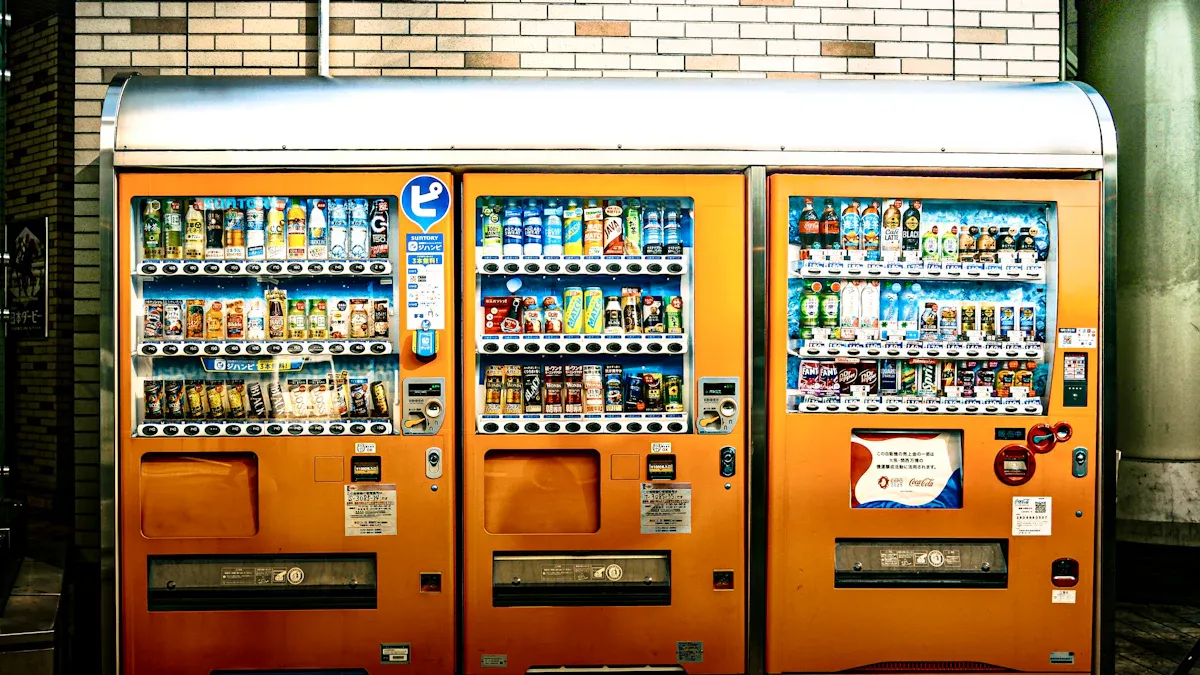
When you ask, "how much does a vending machine cost," you see a wide range. In the U.S., new vending machines usually cost between $3,000 and $10,000, while used options can start at just $995. Here’s a quick look at typical prices:
Vending Machine Type | New Price Range | Used Price Range |
|---|---|---|
Basic Snack Machines | $3,000–$4,000 | $1,500–$2,500 |
Combo (snacks+drinks) | $5,000–$6,000 | $2,500–$3,500 |
Drink Machines | $4,000–$6,000 | $995–$1,595 |
Several factors shape vending machine costs, including machine type, technology, features like cashless payments, and ongoing maintenance needs. You want to match vending machine cost to your budget and business goals.
Key Takeaways
New vending machines cost more upfront but offer the latest features, warranties, and require less maintenance at first.
Used vending machines are cheaper initially but may need more repairs and often lack warranties or modern technology.
Refurbished machines provide a balance with lower cost than new ones and better reliability and support than used machines.
Hidden costs like maintenance, location fees, restocking, and repairs can add up and affect your vending machine profits.
Choosing the right machine depends on your budget, business goals, location, and the features that best fit your customers’ needs.
How Much Does a Vending Machine Cost
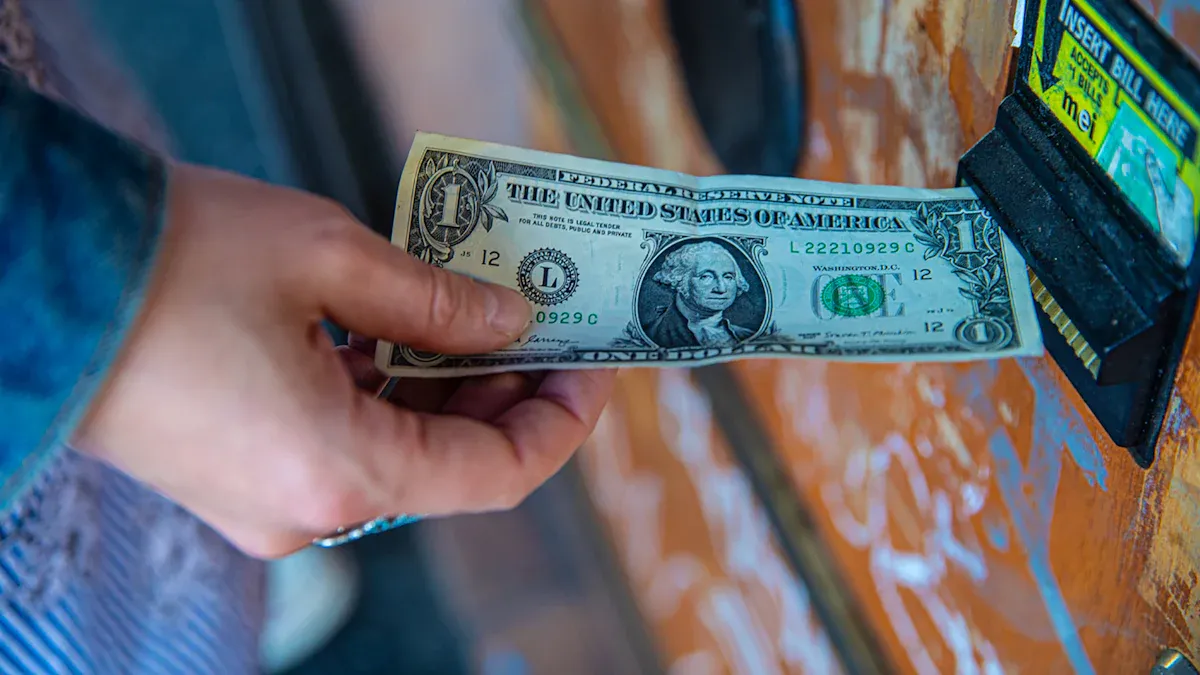
New Vending Machines
When you look for a new vending machine for sale, you will see a wide range of prices. Most new vending machines cost between $3,000 and $7,500, but some specialty models can go even higher. The initial vending machine cost depends on the type and features you choose. Here is a breakdown of typical prices for new machines:
Vending Machine Type | Price Range (USD) | Key Features / Notes |
|---|---|---|
Snack-Only Machines | $2,000 – $3,500 | Basic models, digital displays, energy-saving technology |
Beverage-Only Machines | $3,000 – $5,000 | Refrigeration, dual temperature zones, customizable drinks |
Combo Machines | $5,000 – $7,500 | Snacks and drinks, space-efficient, modern payment systems |
Specialty Machines | $8,000 – $10,000+ | Touchscreens, coffee, ice, eco-friendly, advanced features |
You get more than just a machine when you pay the vending machine price for a new model. Most new vending machines come with the latest technology, such as cashless payment options, energy-efficient LED lighting, and inventory tracking systems. You also receive a warranty, usually covering parts for at least one year. Many brands offer lifetime technical support and remote troubleshooting. Some machines include customizable graphic wraps for branding, adjustable shelving, and ADA-compliant designs. You can often add features like credit card readers or advanced security systems for an extra cost. Delivery and installation services are available, but you may pay additional fees for these options.
Tip: New vending machines are reliable and require less maintenance at the start. You also get peace of mind with warranty coverage and technical support.
Used Vending Machines
Used vending machines offer a lower entry point if you want to save on vending machine costs. The price for a used vending machine usually ranges from $200 to $3,000, depending on the type, age, and condition. You can find a basic snack or drink machine for as little as $200, but most reliable models cost between $1,000 and $4,000. Combo and smart machines cost more, especially if they include modern payment systems or have been refurbished.
Machine Type | Typical Price Range (Used) | Notes on Age and Maintenance Costs |
|---|---|---|
Used Machines | $200 - $600 | Cheapest upfront, higher maintenance possible |
Basic Snack Machines | Lower than new prices | Limited product choices, smaller size |
Full-Service Machines | Lower than new prices | Wider snack and drink selection |
Combo Machines | Lower than new prices | Snacks and drinks, more features |
Smart Machines | Lower than new prices | Advanced tech, may save on maintenance |
When you buy a used vending machine for sale, you need to check several things. The machine’s condition matters most. Look for hidden damage, rust, or worn parts. Ask about the age and maintenance history. Older machines may use more electricity and need more repairs. Make sure all parts work and that the machine meets ADA requirements. Some used vending machines come with modern payment systems or warranties, but these features raise the price. Machines from well-known brands usually cost more, but they offer better reliability and easier access to replacement parts.
Condition and age
Energy efficiency
Payment system (cash, card, or mobile)
Warranty or service agreement
Compliance with safety and accessibility standards
Note: Used vending machines cost less upfront, but you may spend more on repairs and maintenance over time. Machines with advanced features or warranties cost more but can save you money in the long run.
You should compare the vending machine cost for both new and used options. Think about what features you need, how much you want to spend, and how much time you can spend on maintenance. This will help you choose the best vending machine for your business.
Vending Machine Costs Comparison
Price Overview
You can see a big difference between new and used vending machine costs when you compare them side by side. The table below shows the average price range for different types of machines. This helps you understand how much you might spend depending on your choice.
Type of Vending Machine | Average Price Range (USD) | Notes on New vs Used Cost Comparison |
|---|---|---|
New Snack Vending Machines | $3,000 to $10,000+ | New machines are significantly more expensive than used, which typically cost much less |
New Drink Vending Machines | $4,000 to $10,000+ | New machines include advanced features increasing price |
New Combo Vending Machines | $3,000 to $5,500+ | New combo machines cost more than used options |
New Pizza Vending Machines | $75,000 to $109,000 | Specialized machines with advanced automation and features |
Used Vending Machines | $200 to $3,000 | Used machines are substantially cheaper, offering budget-friendly options |
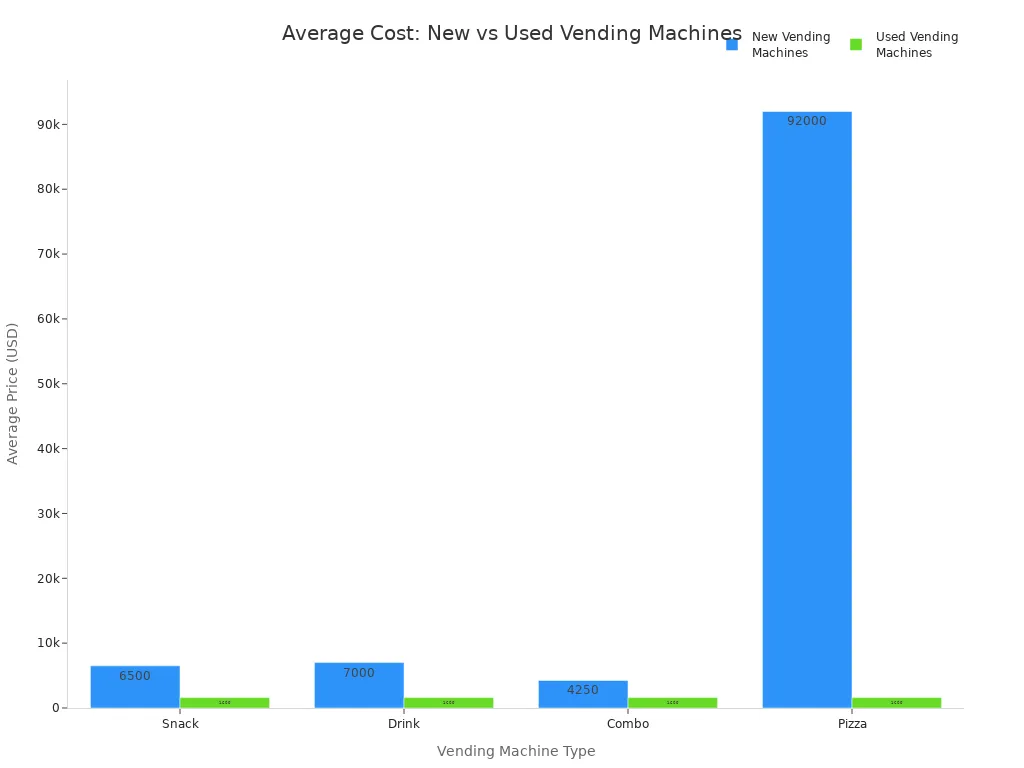
You notice that new vending machine costs can reach over $100,000 for specialty models, while used machines often stay below $3,000. This large gap in price means you have many options based on your budget.
Key Differences
When you compare new and used vending machines, you find several important differences that affect your decision:
Upfront Cost: New machines require a much higher initial investment. Used machines let you start your business with less money.
Technology: New machines often come with the latest features, like touchscreens and cashless payment systems. Used machines may have older technology, but you can sometimes upgrade them for less than the price of a new model.
Warranty and Support: New machines usually include a warranty and technical support. Used machines may not have a warranty, so you might pay more for repairs.
Maintenance Needs: Used machines can need more repairs and regular maintenance. New machines tend to run smoothly at first, which saves you time and money.
Tip: Refurbished machines offer a middle ground. They cost less than new machines, pay off faster, and allow you to add features like branding or security at a lower cost.
You should think about your business goals and how much you want to spend. If you want the newest technology and less hassle, a new machine may be best. If you want to save on vending machine cost and do not mind some extra work, a used or refurbished machine could be a smart choice.
Cost Factors
Machine Type
The type of vending machine you choose has a big impact on cost. Snack and beverage machines usually cost between $3,000 and $5,000. Advanced models can reach $10,000. Cold food machines cost more because they need special refrigeration and expert repairs. Specialty machines, like those for vape or cigarettes, have higher prices due to extra security and expensive products. Bulk vending machines are the cheapest. They work without electricity and have low maintenance costs. Ice vending machines need a large investment, around $20,000, but they have low ongoing costs and high profit margins.
Vending Machine Type | Typical Filling Cost Range (USD) |
|---|---|
Snack Machines | |
Beverage Machines | $300 - $800 |
Combo Machines | $400 - $1,000 |
Features & Technology
Modern vending machine features can raise the price but also improve your business. Machines with cashless payment systems, touchscreens, and smart inventory tracking cost more upfront. These features make it easier for customers to buy products and help you manage stock. Energy-efficient machines save money on electricity over time. Premium brands offer better reliability, which can lower long-term costs. If you want to attract more customers, advanced vending machine features like mobile payments and AI-driven data analysis can help. These upgrades often pay for themselves by increasing sales and reducing waste.
Feature/Technology | Description | Impact on Pricing and Operations |
|---|---|---|
Cashless Payment Systems | Accept cards and mobile payments | Higher cost, more sales, less cash handling |
Smart Features | Inventory tracking, remote monitoring | Higher cost, less downtime, better efficiency |
Energy Efficiency | Uses less electricity | Higher cost, lower bills, longer machine life |
Tip: Investing in the right features can boost your profits and make your vending machine stand out.
Maintenance
You need to plan for ongoing maintenance costs. Regular cleaning, software updates, and part replacements keep your machine running well. Monthly maintenance usually costs $50 to $150. Minor repairs, like fixing coin mechanisms, cost $20 to $100. Major repairs, such as cooling system fixes, can reach $500. Newer machines need fewer repairs but may require software updates. Older machines need more checks and part replacements. Working with skilled technicians helps you save time and money.
Inspect your machine often to catch problems early.
Use real-time monitoring tools to plan service visits.
Set up a maintenance calendar for cleaning and part changes.
Adjust service based on machine age and usage.
Location & Delivery
Where you place your vending machine affects the total cost of ownership. Location fees can range from $50 to $1,500 per month. High-traffic spots cost more but can bring in more sales. Some locations charge a flat fee, while others take a percentage of your sales. Delivery costs include moving the machine and restocking it. These costs add up and can lower your profit if not managed well. Always factor in both location and delivery when you calculate your total costs.
Note: Choosing the right location and planning for delivery costs are key steps to keeping your vending business profitable.
New Vending Machines: Pros & Cons
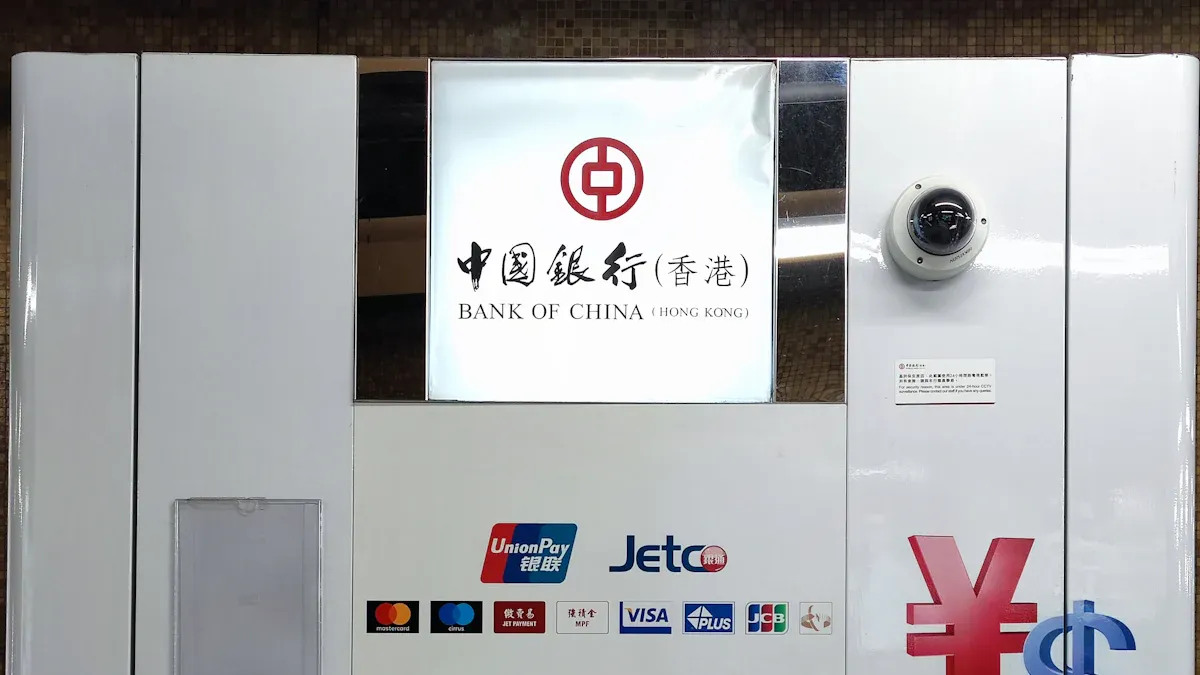
Advantages
When you choose new vending machines, you gain several important benefits:
You receive a manufacturer-backed warranty, usually lasting six to twelve months. Some companies offer extended protection, like the Solid Shield Warranty, which covers up to three years. This warranty covers mechanical and electrical failures, so you avoid unexpected repair bills.
If you are not satisfied with your machine’s performance, you can often replace it. This gives you peace of mind as you start your vending business.
New vending machines offer the latest features. You get advanced payment systems, energy-saving technology, and smart inventory tracking. These features help you attract more customers and manage your business easily.
You enjoy reliable operation. New machines rarely break down, so you do not lose sales from unexpected malfunctions.
Enhanced security features protect your investment. These machines reduce the risk of theft and keep your products safe.
You have access to a global network of authorized service providers. This means you get fast repairs and expert help when you need it.
Tip: A strong warranty and modern features help you maximize uptime and keep your vending business running smoothly.
Disadvantages
You should also consider the drawbacks before buying new vending machines:
You must pay a high upfront cost. This large payment can strain your budget, especially if you are just starting out.
You take on all maintenance and repair costs after the warranty ends. These expenses can add up over time.
New vending machines can lose value as technology changes. When new features come out, your machine may seem outdated to customers.
If you want to upgrade, you may need to invest in another new machine, which increases your long-term costs.
Note: Weigh the benefits of advanced features and reliability against the higher initial investment and possible depreciation.
Used Vending Machines: Pros & Cons
Advantages
When you look at used vending machines, you find many benefits that can help your business grow. You spend less money at the start, which makes it easier to get into the vending business. Many people choose used vending machines because they want to save money and see profits faster. Here are some key advantages:
Lower initial cost: Used vending machines cost much less than new ones. You can buy several machines for the price of one new model.
Faster return on investment: Because you pay less upfront, you start making money sooner. Your business can become profitable in a shorter time.
Proven reliability: Many used vending machines come from trusted brands. These machines have a track record of working well for years.
Wide availability: You can find many types of used vending machines for sale. This lets you pick the best model for your needs without waiting for long shipping times.
Lower risk: You can test new locations or products with less financial risk. If a spot does not work out, you have not lost a lot of money.
Environmental benefits: Buying used vending machines helps the planet. You support recycling and reduce the need for new manufacturing.
Tip: Used vending machines are a smart choice if you want to start small, try new ideas, or expand your business quickly.
Disadvantages
You should also know the downsides before you buy a used vending machine for sale. Some problems can cost you time and money later. Here are the main disadvantages:
Higher maintenance needs: Used vending machines may break down more often. You might spend more on repairs and replacement parts.
Outdated technology: Some used vending machines do not have modern features like cashless payments or remote monitoring. This can make them less attractive to customers.
Limited or no warranty: Most used vending machines do not come with a warranty. If something goes wrong, you pay for all repairs.
Unknown history: You may not know how the previous owner cared for the machine. Hidden damage or worn-out parts can lead to extra costs.
Less energy efficiency: Older machines often use more electricity. This can raise your monthly bills.
Note: Always inspect a used vending machine carefully before you buy. Ask about its age, service history, and any upgrades.
Refurbished Machines
What to Know
When you look at refurbished machines, you see a smart choice between new and used options. Refurbished vending machines go through a detailed process to make sure they work like new. Here is what happens during refurbishment:
Technicians gut and disassemble the machine.
They pressure wash and dry all parts.
Metal parts get sanded, cleaned, primed, and painted with two coats of industrial paint, then topped with clear enamel.
The machine is reassembled with new trim, keypad buttons, seals, labels, and light bulbs.
All electronic parts, like bill acceptors, coin changers, control boards, and displays, are rebuilt. No old electronics are reused.
Trays and spirals are cleaned and painted.
Custom prices are set, and labels are installed.
The machine is tested, palletized, strapped, and wrapped for safe shipping.
You get a 6-month warranty on rebuilt bill acceptors, coin changers, and other key electronics. This warranty gives you peace of mind and lowers your risk. Refurbished machines are inspected and repaired by experts, so you know what you are getting.
Tip: Always ask about the refurbishment process and warranty before you buy. This helps you avoid surprises and ensures you get a reliable machine.
Cost & Value
Refurbished machines offer strong value for your money. You pay much less than you would for a new machine, but you get more support and reliability than with a used one. Most refurbished machines cost 50–70% less than new models. Used machines can be even cheaper, but they often come with no warranty or support.
Machine Type | Cost (USD) | Payoff Time (Years) at 10 Sales/Day |
|---|---|---|
New Snack Machine | 4.39 | |
Refurbished Machine | 1,700 | 1.86 |
You see that refurbished machines pay off in less than half the time of new ones. Most vending accounts do not make enough money to cover the high cost of new machines quickly. Refurbished vending machines give you a safer, more reliable option than used machines. You get support, rebuilt parts, and a warranty, which lowers your risk of costly repairs.
Refurbished machines are inspected, repaired, and backed by sellers.
You avoid the unknowns and risks that come with used machines.
You get a mid-range option that balances cost and reliability.
Note: Refurbished machines help you start or grow your vending business without breaking the bank.
Hidden Costs
When you buy a vending machine, you need to plan for more than just the sticker price. Many owners face hidden costs that can affect profits. These expenses often surprise new operators, so understanding them helps you avoid mistakes.
Typical Cost Range | Description and Impact | |
|---|---|---|
Maintenance & Repairs | $500 - $1,500 annually per machine | Fixing jams, motor or card reader problems; older or used machines may need more repairs. |
Location Fees | $50 - $100 monthly or 5% - 25% revenue share | Rental or revenue-sharing with property owners; can lower your earnings. |
Restocking Expenses | $500 - $1,000 (vehicle costs) | Costs for keeping machines filled, including travel and delivery. |
Staffing & Training | $500 - $7,000 | Wages for workers and training to keep machines running smoothly. |
Utility & Electricity | Variable | Power bills depend on machine type and features. |
Insurance & Regulatory Fees | Variable | Permits, inspections, and insurance to keep your business legal and safe. |
Site Preparation & Installation | Variable | Delivery, setup, and custom branding for your machine. |
Repairs
Repairs can become a major hidden cost, especially if you own older or used machines. You might pay $500 to $1,500 each year for fixing problems like stuck products, broken motors, or payment system failures. Emergency repairs cost more and can lead to lost sales while your machine is out of service. Regular maintenance, such as cleaning and checking parts, helps prevent bigger issues. If you buy from a reputable supplier, you get machines that have been inspected and refurbished. These suppliers offer warranties and support, which lowers your risk of expensive repairs and downtime.
Extra Fees
Extra fees can add up quickly. Location fees often range from $50 to $100 per month, or you may need to share 5% to 25% of your revenue with the property owner. Restocking your machine costs money, too. You need to pay for gas, vehicle upkeep, and sometimes extra staff. Other hidden costs include insurance, permits, and utility bills. If you want a prime spot, you may pay higher placement fees or legal costs for contracts. Buying from a trusted supplier helps you avoid machines with hidden problems that lead to extra fees.
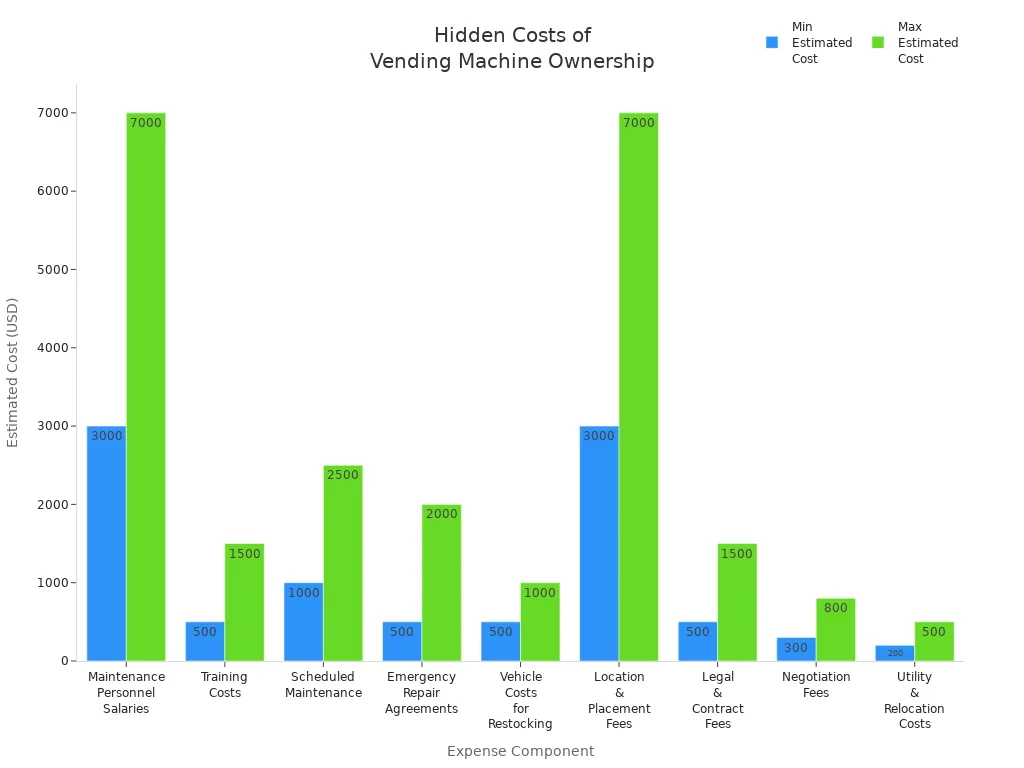
Tip: Always ask for a full breakdown of all possible costs before you buy. This helps you plan your budget and avoid surprises.
Choosing the Right Option
Budget
You need to set a clear budget before you start your vending machine business. Begin by listing all fixed costs, such as the price of the machine, and variable costs, like restocking and maintenance. Calculate your break-even point by estimating daily sales and profit per sale. This helps you see how long it will take to recover your investment and start earning real profit. Remember to include other expenses in your budget, such as insurance, licenses, and technology upgrades. These costs can affect your vending machine profit over time.
A smart budget also considers long-term planning. Think about machine depreciation and resale value. Plan for regular maintenance and possible upgrades. If you buy in bulk or choose high-traffic locations, you can increase vending machine profit and lower costs. Your budget should match your business goals and expected revenue. A realistic budget helps your vending machine business grow and stay profitable.
Tip: Always review your budget as your vending machine business expands. Adjust for new costs and changing sales to keep your profit on track.
Business Goals
Your business goals shape the type of vending machine you choose. If you want to serve schools, gyms, or offices, pick machines that fit your target market. For example, schools may need USDA-compliant snacks, while gyms might want high-protein options. Think about product flexibility. Some machines handle snacks, drinks, or specialty items. Choose machines with payment technology that matches customer needs, like card readers or mobile payments. Smart monitoring features help you track sales and inventory, making it easier to boost vending machine profit.
Business Goal / Consideration | Explanation / Example |
|---|---|
Target Market Alignment | Match products to customer needs (e.g., healthy snacks in schools) |
Product Flexibility | Choose machines that support your product range |
Payment Technology | Offer cashless and mobile payment options |
Smart Monitoring Features | Use real-time tracking for sales and inventory |
Location-Specific Requirements | Ensure machines meet local rules and branding needs |
Set clear goals for your vending machine business. Decide if you want fast profit, steady growth, or a mix of both. Your goals will guide your choices and help you reach the best vending machine profit.
Location
Location is key to vending machine profit. High-traffic spots like offices, hospitals, and schools bring more customers and higher sales. Study the local area to match your products to customer needs. Good visibility and easy access encourage more people to buy, which increases vending machine profit. Watch out for competition nearby. Offer unique products or better payment options to stand out.
You must also consider costs tied to each location. Rent, maintenance, and legal fees can change from place to place. Negotiate contracts to get the best terms for your vending machine business. Use tools like foot traffic counters to pick the best spots. The right location can make your vending machine business more successful and boost your profit.
Note: The best location balances high sales with manageable costs. Always review your vending machine profit by location to find what works best.
Choosing the right vending machine for your vending machine business means balancing initial cost, reliability, and long-term expenses. Use the table below to compare key factors:
Factor | New | Used | Refurbished |
|---|---|---|---|
Upfront Cost | High | Low | Medium |
Warranty | Yes | Rare | Often |
Maintenance | Low | High | Medium |
Features | Advanced | Basic | Upgraded |
You can boost vending machine profit by matching machine type to your location and customer needs. Always plan for ongoing costs, as these affect profit and the success of your vending machine business. Start small, track vending machine profit, and adjust your vending machine business strategy for the best results.
FAQ
How much does it cost to restock a vending machine?
You usually spend $200 to $1,000 to restock a vending machine. The amount depends on the type of products you choose and how many items you need to refill.
Can you upgrade an old vending machine with new features?
Yes, you can add features like card readers or better lighting to many older machines. Upgrades help your machine accept more payment types and attract more customers.
Do vending machines need special insurance?
You should get insurance for your vending machine. Insurance protects you from theft, damage, or accidents. Some locations may require proof of insurance before you place your machine.
How often should you service a vending machine?
You should check and clean your vending machine every week. Regular service keeps your machine working well and helps you avoid bigger repair costs later.
See Also
Understanding The Expenses Involved With Vending Machines
Pricing Factors For Customized Vending Machines Explained
Detailed Cost Analysis Of Vending Machines And Their ROI
